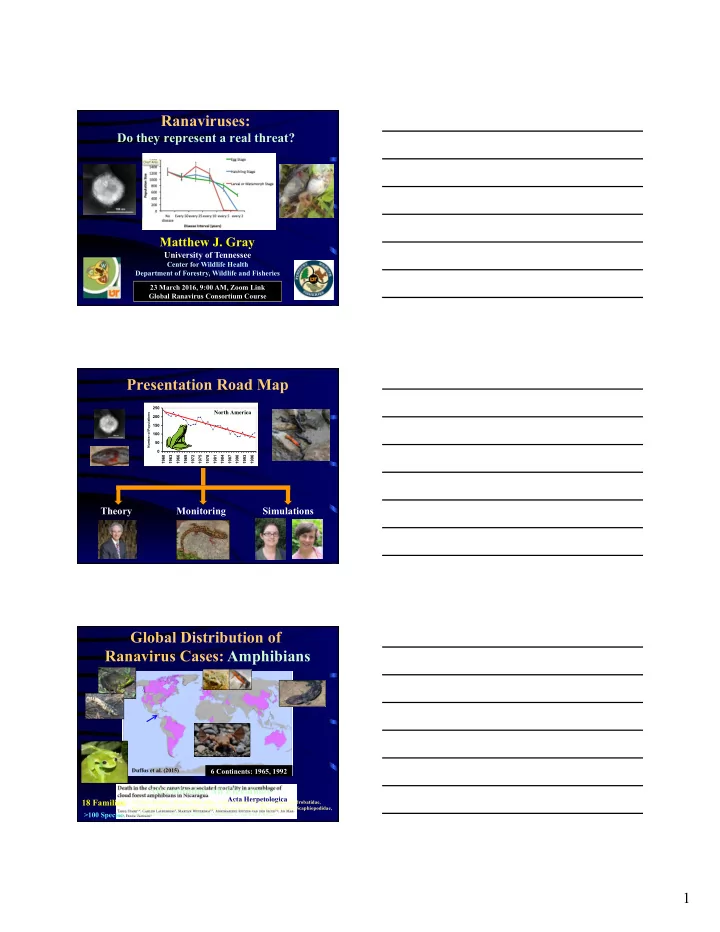

Ranaviruses: Do they represent a real threat? Matthew J. Gray University of Tennessee Center for Wildlife Health Department of Forestry, Wildlife and Fisheries 23 March 2016, 9:00 AM, Zoom Link Global Ranavirus Consortium Course Presentation Road Map 250 North America Number of Populations 200 150 100 50 0 1960 1963 1966 1969 1972 1975 1978 1981 1984 1987 1990 1993 1996 Theory Monitoring Simulations Global Distribution of Ranavirus Cases: Amphibians Duffus et al. (2015) 6 Continents: 1965, 1992 All Latitudes, All Elevations Acta Herpetologica 18 Families: Alytidae, Ranidae, Hylidae, Bufonidae, Centrolenidae, Craugastoridae, Dendrobatidae, Discoglossidae, Leptodactylidae, Pipidae, Myobatrachidae, Rhacophoridae, Scaphiopodidae, >100 Species Ambystomatidae, Salamandridae, Hynobiidae, Cryptobranchidae 1
Mass Mortality Events Larvae Adults Maine 2013 Die-off 1000 carcasses/m 2 >200,000 dead qPCR Confirmed Wheelwright et al. (2014) <24 hrs 6/14/13 6/15/13 Compromised Organs & Rapid Death Kidney Hemorrhages Pale and Swollen Liver It attacks quickly killing hosts as fast as 3 days! Hoverman et al. (2011a) 2
Organ Destruction 3 Primary Organs: Liver, Spleen, and Kidney Bollinger et al. (1999) Miller et al. (2007, 2008, 2011) D. Miller D. Miller D. Miller Liver Necrosis Spleen Necrosis Kidney Degeneration Pathogenesis Target Organ Failure Heart Failure Toxicosis, Anemia What if Ranaviruses were Pathogenic to Humans? 12 – 32 C Chinchar (2002) Monday Wednesday No Vertebrate Pathogen: Diversity of Hosts or Kills as Quickly There is no Cure! Fever Hands, Feet, Legs Swollen Friday Sunday Bedridden, Body Enlarged 2X, Lesions, Begging Dr. Death (Jack Kevorkian) Hemorrhaging Internally and from Orifices for a quick end! Are Ranaviruses Capable of Causing Local Extirpations and Species Declines? 250 Number of Populations 200 150 100 50 0 1960 1963 1966 1969 1972 1975 1978 1981 1984 1987 1990 1993 1996 Muths et al. Collins & Crump (2009) (2006) 3
Traditional Theory (Anderson and May 1979) Extirpation is possible if: Frequency Dependent (1) Multiple Host Species Where Susceptibility Differs • Asymptomatic Carriers Is at least one of these conditions satisfied in the ranavirus-host system? (2) Environmental Reservoir • Survive Outside Host (3) Clustering of Individuals • Sexually transmitted disease Evidence of Multiple Hosts (Moody and Owens 1994, Marschang et al. 1999, 2005; Hyatt et al. 2002; Allender et al. 2006; Duffus et al. 2008, Picco et al. 2010; Hoverman et al. 2011a; Brenes 2013; Waltzek et al. 2015) UT: 34 Species (1) Multiple-species Pathogen: (2) Other Ectothermic Vertebrates Evidence of Multiple Hosts Graptemys pseudogeographica kohni Apalone ferox Eastern River Cooter – no infection Brenes et al (2014a) 5 Fish & 3 Turtle Species Control ¡ ¡ ¡ ¡Turtle ¡ ¡ ¡ ¡ ¡ ¡ ¡Fish ¡ ¡ ¡ ¡ ¡ ¡Amph ¡ ¡ ¡ Brenes et al. (2014a) Gambusia affinis Ictalurus punctatus Control Turtle Fish Amph Control Turtle Fish Amph 4
Evidence of Interclass Transmission Brenes et al. (2014b) Ranaviruses can infect multiple host species, transmission can occur between them, & some hosts may serve as asymptomatic carriers – #1 Met Evidence of Environmental Persistence (1) EHNV Persistence (Langdon 1989) Ranaviruses can be remain viable outside the host • Distilled Water: 97 d for considerable duration (permanent wetlands at • Dry Infected Tissue: 113 d colder temperatures). – #2 Met • Frozen Infected Tissue: 2 yr Johnson & Brunner (2014) & Geng et al. (2) FV3, FV3-like (Nazir et al. 2012) **1 week at 20-25 C** 20 C = • Soil: 13-22 d • PW (unsterile): 22-34 d • PW (unsterile): 58-72 d • Soil: 30-48 d 4 C = (T-90 Values) Evidence of Frequency Dependent Transmission (1) Breeding (Brunner et al. 2004) • Juvenile/Adult: Sub-lethal Infections Frequency dependent transmission is possible in • High Transmission Collins & Crump (2009) larval and adult age classes – #3 Likely. • Period of Stress (Rollins-Smith 2001) (2) Larval Clustering • Increase Contact Rates • Vegetation Reduction (Greer et al. 2008) Local Extirpations and Declines? YES, all 3 characteristics met in the Ranavirus-Host System 5
Evidence of Local Extinction Dr. Stephen Price Current Biology 24:2586-2591 University College London Picos de Europa National Park Ranavirus die-offs with six species 2007-2012 Evidence of Local Extinction Dr. Amber Teacher Animal Conservation Southeastern England 13:514-522 1996/97 and 2008 Teacher et al. 2010 81% A. Teacher Ranavirus (+) Larger Populations populations Greatest 81% Median Proportional Reduction Declines A. Teacher Evidence of Local Extinction Dr. Jim Petranka Biological Conservation 138:371-380 Tulula Wetland Complex, NC Wetlands 1998-2006 23:278-290 Persistence Possible Recruitment at most from Source wetlands failed due Populations to ranavirus Rescue Effect Earl et al. (in review): Immigration at natural levels may be insufficient 6
Ranavirus Landscape Prevalence Tennessee Ponds n = 40 ponds Hoverman et al. (2011b) 2 years, 4 seasons Green Frog, Bullfrog, Ranaviruses are widely distributed hence have the Pickerel Frog, Eastern Newt, Tiger and potential to have landscape scale impacts. Spotted Salamanders Ranavirus Distribution: 83% of Ponds Sampled Hotspots: >40% in 15 out of 40 Ponds Sampled • 85% Infection • 100% Infection (morbid and dead) EcoHealth 9:36-48 Cry Wolf or Valid Risk? Should we be Concerned? • Ranavirus Die-offs have Global Distribution • Ranavirus Prevalence can be High • Ranaviruses Infect Multiple Ecothermic Vertebrate Species with Different Susceptibilities • Interclass Transmission is Possible – Abundant Reservoirs • Ranavirus Persistence is Long • High Transmission: Breeding and for Schooling Spp. Epidemiological Theory, Modest Field Data, AND Initial Simulations (next) Support the Premise that Ranaviruses Could Cause Local Population Extirpations and Contribute to Species Declines More Research: What myriad of factors (abiotic, biotic; natural, anthropogenic) interact to result in ranavirus outbreaks? Few longitudinal studies & simulations. Questions?? Photo: M. Niemiller mgray11@utk.edu 865-974-2740 7
Recommend
More recommend